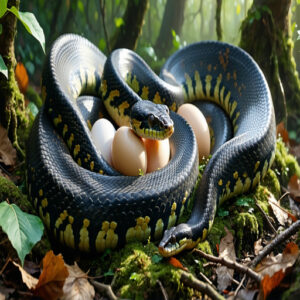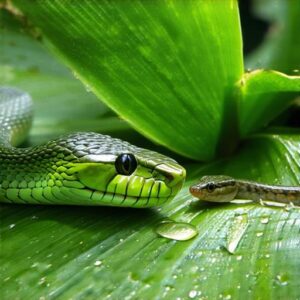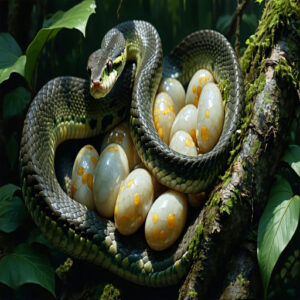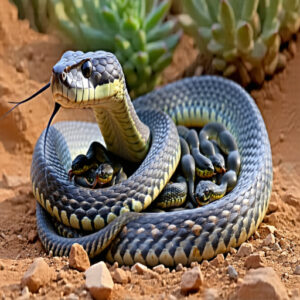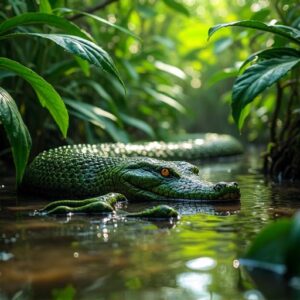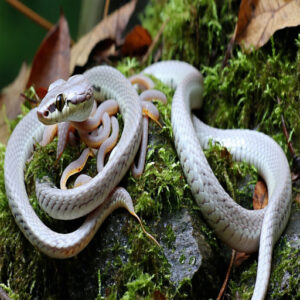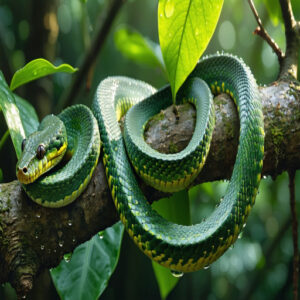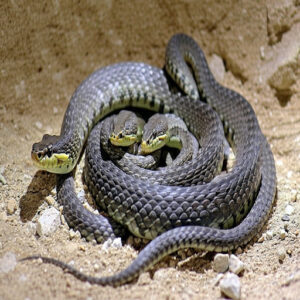This site is supported by our readers. We may earn a commission, at no cost to you, if you purchase through links.
 Not all snakes bother with laying eggs—some, like boa constrictors and garter snakes, go all-in on live birth.
Not all snakes bother with laying eggs—some, like boa constrictors and garter snakes, go all-in on live birth.
These snakes either develop their babies inside egg-like sacs (called ovoviviparous) or skip eggs altogether, nourishing their young directly (viviparous).
The result? Babies are born ready to slither into the world.
Garter snakes can store sperm for years to up their genetic game, while anacondas give birth to up to 30 young after months of internal development.
Even sea snakes deliver live offspring in the ocean! It’s nature’s way of ensuring snakelets survive, especially in harsher climates.
Intrigued? There’s more to uncover!
Table Of Contents
- Key Takeaways
- Snakes That Give Live Birth
- How Do Snakes Reproduce?
- Snakes With Unique Reproduction
- The Evolution of Live-Bearing Snakes
- What is The Largest Snake Ever Found?
- Snakes That Give Birth to Live Young
- Why Do Some Snakes Give Birth to Live Young?
- Frequently Asked Questions (FAQs)
- Do snakes give birth to live young?
- How to identify when a snake has finished giving birth?
- Which snakes give live birth?
- Do snakes give birth or lay eggs?
- What kind of snakes give live birth?
- Do copperheads give live births?
- Do cottonmouths give live birth?
- What snakes in the United States lay eggs?
- Do copperheads give live birth?
- What snakes can have babies without mating?
- Conclusion
Key Takeaways
- Some snakes, like boa constrictors, garter snakes, and anacondas, give live birth instead of laying eggs, offering their young better survival chances.
- Live-bearing snakes thrive in harsh climates or risky terrains by nurturing their babies internally until they’re ready to face predators and the environment.
- Garter snakes can store sperm for years to maximize reproduction efficiency, while boas and anacondas carry their embryos for months, giving birth to multiple offspring.
- Ovoviviparous snakes, like rattlesnakes, hatch their eggs internally before giving live birth, combining the advantages of both egg-laying and live birth methods.
Snakes That Give Live Birth
Believe it or not, some snakes skip the egg-laying step altogether and give birth to live young—a brilliant reproductive strategy that guarantees survival.
These viviparous snakes, like garter snakes, boa constrictors, and the massive anaconda, have fascinating adaptations.
Garter snakes can even store sperm for years, like nature’s version of a time capsule, maximizing genetic possibilities.
Boa constrictors? They’re show-offs with litters of up to 65 babies—talk about maternal care overload!
Anacondas take it up a notch, carrying embryos for four months before releasing a brood of 30.
For more specific examples, explore this list of live-bearing snakes.
For ovoviviparous snakes and fully live-birthing species, this approach shields young from predators, proving nature’s knack for making things work just right.
How Do Snakes Reproduce?
Snakes have three fascinating ways to reproduce: laying eggs (oviparous), giving live birth (viviparous), or a mix of both (ovoviviparous).
You might be surprised to learn that some species even carry their eggs internally until they’re ready to hatch—talk about multitasking, and this unique method is also known as ovoviviparous.
Oviparous
Ever wonder how snakes handle motherhood?
Many are oviparous, meaning they lay eggs.
Fertilization methods vary, but once fertilized, the eggs develop into tiny snake embryos.
You might imagine a python coiling protectively around her clutch—classic Egg Incubation at work.
Hatchlings? Born ready, with instincts on full throttle.
Curious about oviparous vs viviparous snakes?
Oviparous snakes rely on egg-laying, unlike ovoviviparous snakes, which seem to skip the nest-building drama.
Nature’s playbook never gets old!
Viviparous
Think of viviparous snakes as nature’s dedicated parents.
They don’t just lay eggs but keep their embryos developing safely inside.
The result? Live birth, with baby snakes nurtured in ideal conditions.
Snakes have fascinating mating rituals, as detailed on this informative page about snake mating processes.
You’ll find these snakes thriving in extremes—deserts to rainforests.
Viviparity in reptiles guarantees constant warmth, nutrition, and protection during snake gestation, a genius move for survival.
Ovoviviparous
While viviparous snakes nourish their young directly through a placenta, ovoviviparous snakes take a fascinating middle road.
You’ll find these crafty reptiles keeping their eggs inside until they’re ready to hatch, giving their babies the best of both worlds.
- The eggs develop safely within mom’s body
- Babies feed on yolk sacs instead of a placenta
- Birth timing syncs perfectly with environmental conditions
- Young emerge ready to face the world
Just like having a built-in incubator, ovoviviparous snakes protect their developing eggs internally until hatching happens moments before birth.
It’s nature’s way of ensuring maximum survival chances for the next generation.
Understanding ovoviviparous snake characteristics is essential to appreciating their unique reproductive strategies.
Snakes With Unique Reproduction
You’ll be amazed to discover that some snakes don’t lay eggs at all – instead, they keep their developing babies inside until they’re ready to enter the world.
Among these special live-bearing serpents, you’ll find fascinating creatures like the Rinkhals, which can spray venom while protecting its developing young.
The Rinkhals and sea snakes that birth their babies directly into ocean waters are examples of such unique behavior.
Rinkhals
Meet the Rinkhals, southern Africa’s remarkable spitting cobra.
These unique snakes pack a double surprise – they’re ovoviviparous snakes that give live birth, and they can spray venom up to 8 feet when threatened.
Found in grassland habitats, they’re actually quite shy despite their fierce reputation.
They can be found in various southern African habitats, including grasslands, savannas, and shrublands.
Inside mom’s body, 20-35 babies develop safely before entering the world ready to face life’s challenges.
Sea Snakes
Swimming champions of marine adaptation, sea snakes have mastered life in their sea habitat through remarkable birth strategies.
These ovoviviparous serpents skip the egg-laying drama, delivering fully-formed youngsters ready to tackle ocean life.
This species thrives across a vast range, inhabiting the Indo-Pacific ocean regions.
You’ll spot the yellow-bellied sea snake leading this aquatic revolution—it’s so well-adapted, it can’t even move properly on land.
Their specialized features, including valved nostrils and paddle-tails, showcase perfect saltwater survival.
Water Snakes
Water habitats come alive with these remarkable freshwater species, which have perfected their aquatic adaptations over millions of years.
They’re surprisingly docile and easy to handle, making certain species popular in the pet trade.
You’ll find these viviparous snakes giving birth to 10-30 wriggly youngsters in late spring, a fascinating display of snake reproduction in action.
In wetland ecology, they’ve mastered life both in and around water, spending nearly all their active season near their aquatic homes.
The Evolution of Live-Bearing Snakes
Recent discoveries show that live birth in snakes dates back an impressive 175 million years.
This reproductive adaptation has evolved as snakes’ secret weapon for survival in challenging environments.
Here’s how snake reproduction evolved over time:
- Ancient origins: Scientists found that the ancestor of all snakes and lizards likely gave birth to live young, rather than laying eggs
- Flexible evolution: Species have switched between egg-laying and live birth multiple times throughout history, showing remarkable genetic variation
- Modern advantages: Live-bearing evolved especially in cold climates, where internal incubation gives babies better protection
Snake embryology reveals fascinating reproductive adaptations.
Viviparous snakes, like boas and rattlesnakes, nourish their young internally, while ovoviviparous species keep their eggs safe inside until hatching.
A 47-million-year-old fossilized snake even shows this wasn’t just a modern innovation
-it’s nature’s time-tested survival strategy.
What is The Largest Snake Ever Found?
Scientists just unearthed a massive serpent that dwarfs today’s largest snake species, named Vasuki indicus, this prehistoric giant stretched an incredible 11-15 meters long, surpassing even the legendary Titanoboa.
Found in India’s Gujarat region in 2024, this huge reptile discovery reveals fascinating details about ancient ecosystems.
Here’s what makes Vasuki truly remarkable:
- Measured longer than a school bus at up to 15 meters
- Lived 47 million years ago in ancient swamplands
- Could’ve weighed more than a ton, based on fossil evidence
For comparison, today’s record holders seem modest – the reticulated python holds the length record at 10 meters, while the heaviest recorded green anaconda weighed 227 kilograms with an 8.43-meter length.
Imagine spotting that snake length record holder slithering through the jungle, it’s mind-boggling to think these massive serpents once ruled their prehistoric domains, making our modern giants look like garden snakes.
Snakes That Give Birth to Live Young
You’ll be amazed to discover that some snake species, including garter snakes and anacondas, don’t lay eggs but instead give birth to fully formed baby snakes.
Just like mammals, these live-bearing snakes keep their developing young inside their bodies until they’re ready to face the world, providing them with better protection from predators and harsh environments.
Garter Snakes
North America’s remarkable garter snakes showcase nature’s ingenuity through live birth, delivering between 4 and 80 baby snakes per litter.
You’ll find these viviparous snakes thriving in diverse garter snake habitats, from wetlands to forests.
For further details, explore garter snake lifespan products.
Here’s a closer look:
Diet
Habitat
Lifespan
Venom
Behavior
Boa Constrictors
Remarkable boa constrictors showcase nature’s maternal instincts in their constrictor behavior.
In their native boa habitat, these devoted mothers spend 100-150 days carrying their young.
Their viviparous reproduction style yields 10-30 babies on average, though exceptional mothers can nurture up to 60 neonates.
For ideal wellbeing, consider specialized boa constrictor care products.
During pregnancy, they’ll carefully regulate their temperature and protect their developing offspring with protective coiling behaviors.
Anacondas
Anacondas, one of the largest viviparous snake species, are apex predators lurking in South America’s rainforests and wetlands.
You’ll love their mix of muscle and agility—they constrict prey masterfully and thrive in water.
These giant, live-bearing snakes deliver offspring ready to tackle the wild.
- Anaconda Habitat: Dense rainforests, murky wetlands
- Snake Behavior: Skilled swimmers, ambush predators
- Anaconda Diet: Capybaras, caimans, or sometimes unlucky deer
- Conservation Status: Threatened by deforestation and poaching
Their survival depends on protecting their shrinking world.
White-lipped Snakes
The white-lipped snake is a standout among viviparous snakes, thriving in cold habitats.
Its live birth strategy shields young from harsh environments, an edge many snake species lack.
Found in a wide geographic range across cooler climates, this snake’s venom levels are mild, but its quick reflexes make it fascinating to study.
While some white-lipped snakes mirror their namesake in appearance, their feisty snake behavior keeps them anything but predictable!
Rattlesnakes
Rattlesnakes, notorious for their snake venom and iconic rattles, are masters of desert survival.
These viviparous snakes carry their young in internal eggs, hatching them just before birth—a clever way to protect their offspring from predators.
Found across various rattlesnake habitats, their rattlesnake behavior is a blend of caution and resilience.
So, yes, do rattlesnakes give live births? Absolutely, proving they’re built for survival in some of Earth’s toughest environments!
Amazon Tree Boa
High up in the Amazon ecosystem, the Amazon Tree Boa rules the treetops with its expert tree climbing skills.
These colorful, viviparous snakes skip egg-laying, giving live birth for better survival odds.
They thrive in a humid rainforest habitat, ideally between 70-85% humidity, as detailed on this Amazon Tree Boa care sheet.
Living amidst their native habitat, they hunt birds and small mammals, and this agile snake species blends perfectly into its surroundings, championing snake behavior built for the rainforest canopy.
Why Do Some Snakes Give Birth to Live Young?
Why do some snakes go for live birth instead of eggs? It’s all about playing it smart with their environment.
In places where eggs wouldn’t stand a chance—cold climates, risky terrain, or predator-packed areas—viviparous snakes take matters into their own coils.
By keeping their developing embryos inside, they give their young a head start, safe from harsh conditions and enemies.
This isn’t just a lucky trait; it’s nature’s reproductive strategy in action.
Think of Snake Embryo Development like precious cargo, carefully protected.
It’s also why viviparous species, like boas and rattlesnakes, thrive in wild places others can’t.
Live birth shines as one of evolution’s finest adaptations for snake survival.
Frequently Asked Questions (FAQs)
Do snakes give birth to live young?
Yep, some snakes give live birth!
Boa constrictors, garter snakes, and rattlesnakes skip the egg-laying part.
Instead, they announce tiny, squirmy arrivals already hatched, perfect for traversing harsh environments or dodging predators from day one, being squirmy helps them.
How to identify when a snake has finished giving birth?
Watch for your snake to stop straining or curling, and notice when all babies are active and moving around.
If she settles down and her belly isn’t swollen anymore, she’s likely finished giving birth.
Which snakes give live birth?
Some snakes skip the whole egg-laying routine and go for live birth.
You’ll find species like boas, rattlesnakes, garter snakes, and anacondas doing this.
It’s a clever adaptation, especially in colder or aquatic habitats!
Do snakes give birth or lay eggs?
It’s a jungle out there! Some snakes lay eggs, like birds. Others, surprisingly, give birth to live young, like mammals. It depends on the species.
What kind of snakes give live birth?
Some snakes bring their babies into the world live! Rattlesnakes, boas, and garter snakes are a few of these live-bearing species.
Do copperheads give live births?
Copperheads don’t bother with eggs outside their bodies—they give live birth.
They’re ovoviviparous, meaning the eggs develop internally.
When it’s time, they bring forth live baby snakes, usually late summer or early fall.
Do cottonmouths give live birth?
Regarding cottonmouths, they don’t mess around with eggs—they give live birth.
This helps their young survive in swamps and wetlands, avoiding predators while getting a head start in their murky world.
What snakes in the United States lay eggs?
Egg-laying snakes in the U.S. include kingsnakes, rat snakes, coral snakes, and racers.
These reptiles lay their eggs in hidden spots, like under logs or in leaf litter, ensuring their young start life safe and snug.
Do copperheads give live birth?
You’ll be intrigued to know copperheads skip the eggs entirely—they give live birth.
This method helps their young avoid predators early on.
Their babies, born with venom, are ready to tackle the world right away.
What snakes can have babies without mating?
Some female snakes can reproduce asexually through a process called parthenogenesis. They don’t need a mate to have babies! Pretty cool, huh?
Conclusion
Snakes that give live birth are nature’s curveballs, skipping the classic egg-laying playbook to bring their young into the world fully prepped for life.
Whether it’s garter snakes storing sperm for the perfect moment or anacondas birthing 30 little swimmers, these species show how evolution thrives on adaptability.
It’s all about survival—harsh climates, tough predators, or ocean adventures.
Next time you spot a boa constrictor, remember, live birth is their secret weapon.
Cool, right?
- https://reptile.guide/snakes-that-give-live-birth/
- https://pangovet.com/pet-health-wellness/snakes/snakes-that-give-live-birth-like-mammals/
- https://oddlycutepets.com/snakes-with-live-babies/
- https://www.reptileadvisor.com/snakes-that-give-live-birth/
- https://www.sciencedirect.com/science/article/abs/pii/S019606449470113X

